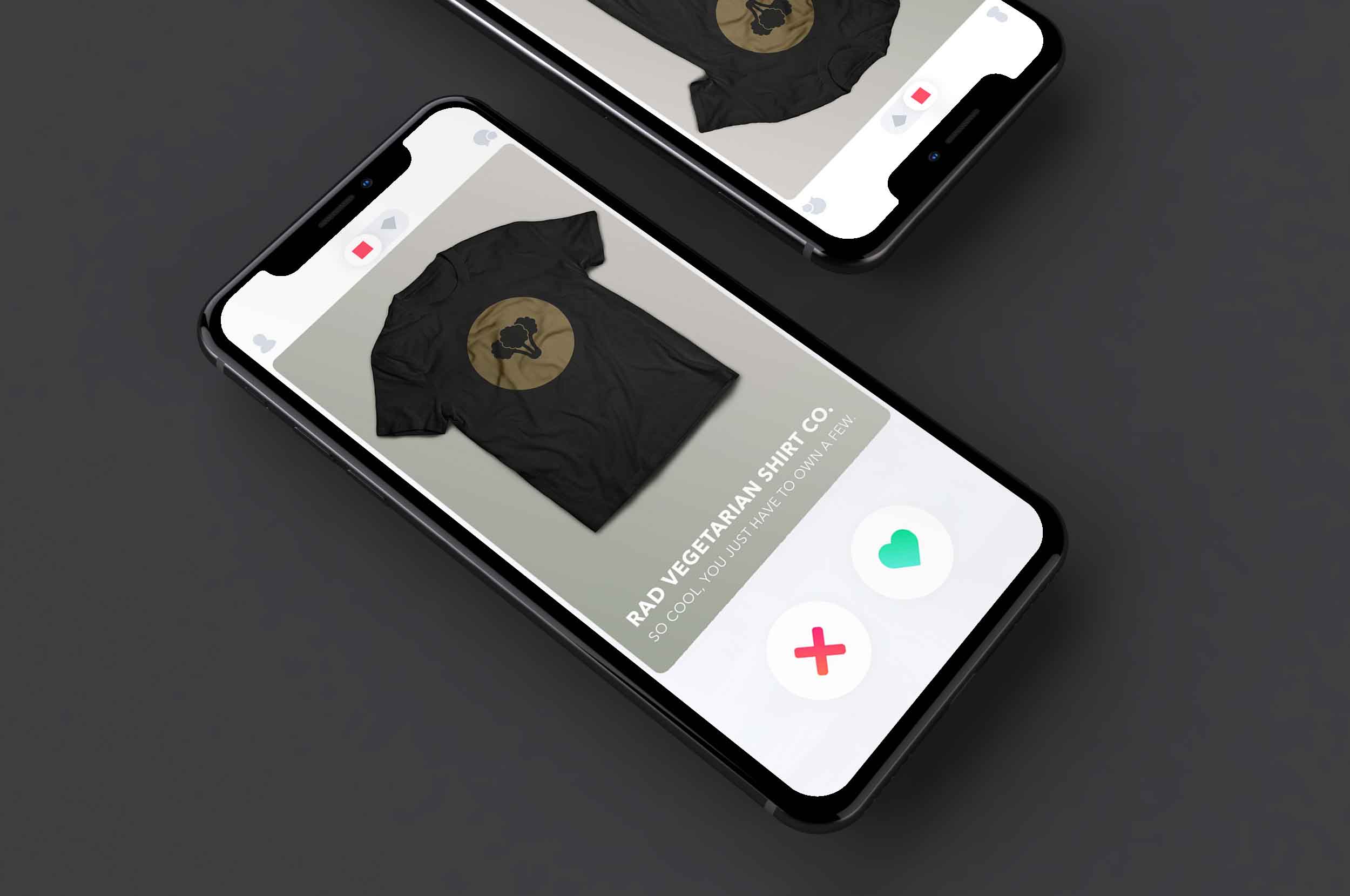By Jacob Freedman
As a wise social media marketer once said, “Relationships are easy. Facebook is hard.” While paid social media campaigns and real-life relationships are far more different than mere apples and oranges in the grand scheme of things, they retain a striking similarity: You need to put your best foot forward to set yourself up for success.
You wouldn’t get married without knowing your spouse well enough, so make sure you’re doing the same with your paid social media audience. By speed dating your potential audience before you get your campaign off the ground, you gain valuable insight about your prospective audience pool. When you factor in mid-campaign insights as well, you’ll be ready to go the distance in your targeting.
Whether you’re spending $50 or $50,000, wouldn’t you want to know where (and toward whom) your carefully planned ad dollars should be going? Us too. We’re not Ask Amy, but if you want to get to the “Happy Ever After” status in your relationship with this audience, read on for tips that will surely propel your campaigns on the road to that state.
Insight, in Mind
Did you know that 11% of American millennials on Twitter shop vegetarian, while only 7% of American baby boomers do the same? Or that 16% of single American Facebook users work in the Food and Restaurants industry, compared to just 6% of married Americans? If you’re launching a vegetarian restaurant chain nationwide, this would be valuable information to have at your fingertips.
Facebook and Twitter’s audience insights not only lets you see a wide swath of data, ranging from occupation category to favorite TV genre, but lets you narrow down your targeting in order to see the overall preferences of the specific audience you want to reach — rather than the entirety of users on the platform. The two sites’ targeting is not identical, but both Twitter and Facebook give you an overall view into the preferences of the users that fuel them.
Let’s say we want to dive deeper into our foray into vegetarian dining. On Twitter, we can see the overall interests of vegetarian shoppers. Check out the screenshot below.
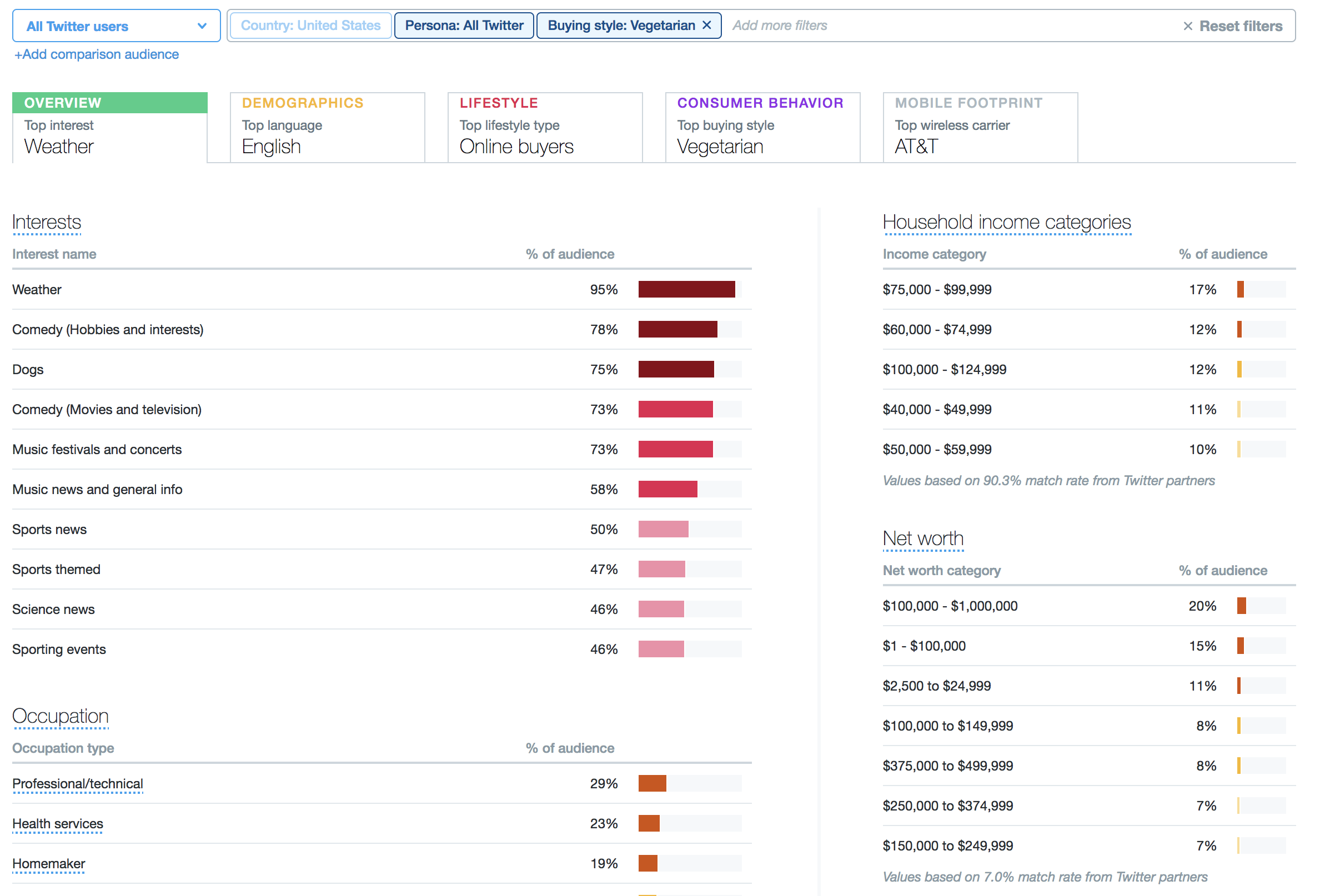
We can also add a comparison audience in order to see how vegetarian shoppers compare to any other demographic. For starters, we want to see how these vegetarian shoppers’ profile compare to every Twitter user, in order to get a better profile of what additional traits they have in common. Twitter’s interface makes it extra-simple to see that these vegetarian shoppers tend to be more interested in bottled water and paper towels, but less interested in salty snacks and cheese.
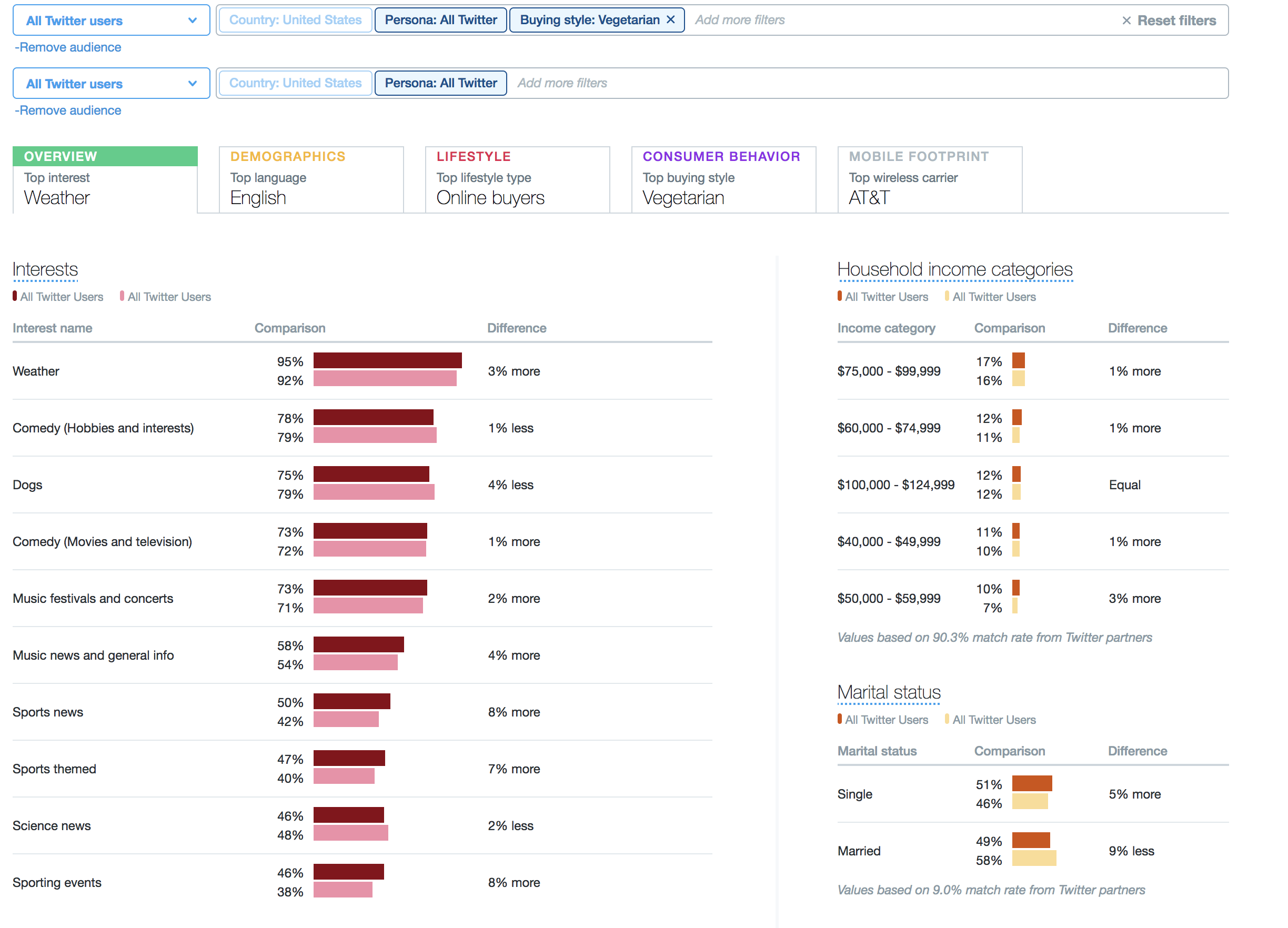
These insights may not be revolutionary in and of themselves, but they show that you actually don’t need any followers or audiences of your own to discover a lot about how social media users behave. Or, if nothing else, brainstorm conversation topics for a first date with a vegetarian.
The Sincerest Form of Flattery
Statistics drive many of our decisions in the paid social media marketing world, but like countless generations before us, it all comes down to a person deciding that they are going to fill out a form, click to learn more, or eventually purchase a product. At the end of the day, just like real love relationships, people can’t be fully quantified. They ultimately decide where their marketing journey will, or will not, take them.
So, as marketers, what are we to do? We put on our socialization hats and start looking at the audiences of competitors whose success we want to emulate (and surpass).
Let’s consider our fictitious brand-new vegetarian restaurant. We would want to look at the Instagram profile of @lifeofavegetarian, a social media influencer from Australia who has more than 70,000 followers. Chances are that most of these 70,000 followers are aligned with the profile of who we’d want to reach with our new venture.
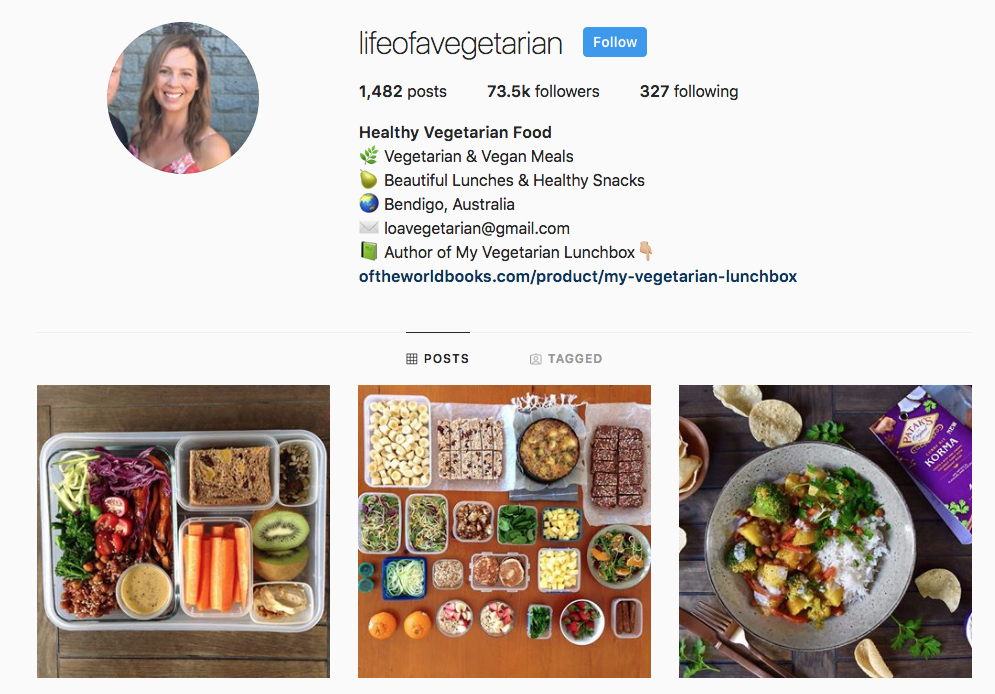
But rather than biting off more than we can chew and looking at each of these followers’ profile, we can take a sampling of the portion of this audience that is especially valuable: the engagers. Users who comment on @lifeofavegetarian’s photos are not only fans, but feel strongly enough about her content to leave a comment. Now, take a few minutes to peruse commenters’ profiles. Do these users tend to also have a dog? At what kind of restaurants do they post selfies? Although social media is never a completely accurate representation of anyone’s life, you can still use this method to get a general gauge of what a vegetarian-focused audience looks like. Literally.
You can also use paid tools to dive even deeper into your competitor’s audiences on Twitter.
Keeping up With the Cool Kids
Hashtags. We all use them, but too often ignore their usefulness as a tool that gives us an immediate look into not only what people are talking about, but how they feel about it. Start your research by looking into hashtags that relate to your brand. For our imaginary-but-aspirational vegetarian restaurant chain, #vegetarianlife, #whatvegetarianseat and #plantbasedlife are a couple of hashtags that would likely be utilized by users posting content relevant to us. By going to these hashtags’ pages (just click on them in a post), you can see the recent posts with the hashtag, allowing you to again view profiles and snoop on users who might be in your target demographic.
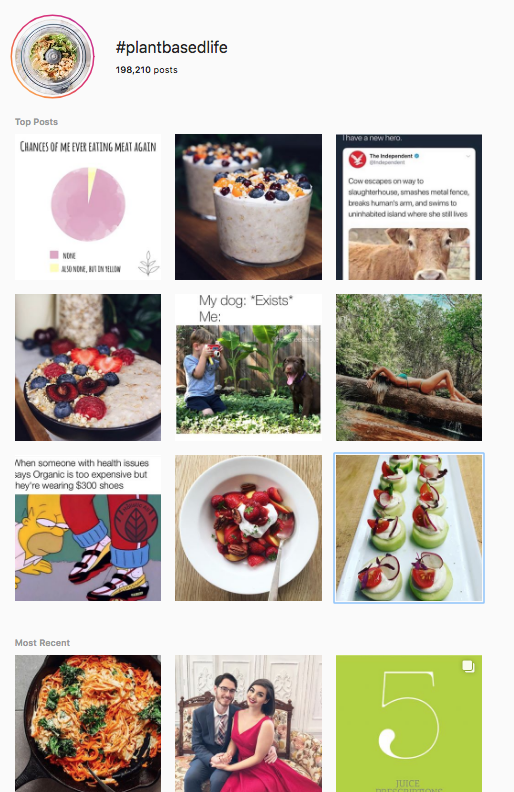
Instagram is especially helpful on the hashtag front. It will show top posts with your hashtag, allowing you to discover influencers or high-follower accounts using said hashtags. This gives you even more profiles and ideal audiences to study. Many of these top posts are also useful because you can see what other hashtags are in the post, allowing you to also click on those and expand your research. This enables you to repeat your process and find more users that are already doing what you seek to do: Use social media to spread their content. You can even follow hashtags, just as you would a user, and see posts with the hashtag showing up in your own feed. If there’s not enough, fish in the sea. Social media can always provide you a new rod.
The Time to Engage
Have you ever had to watch a video ad with the sound off, due to being at work or somewhere loud? Same. Too often, viewing a video without volume makes it difficult to actually understand what is happening. Also, do you have a specific time in the evening where you scroll through your phone or log into your computer to catch up on social media? If you do, you’re not alone.
A number of paid social media platforms, including Facebook and YouTube, allow you to choose both the hours and specific days of the week your ads will be shown. When thinking about your specific product, you will likely find times that, theoretically, would be better to reach your customers. If you’re looking to reach high school students, the hours immediately after class gets out might see more engagement than during the middle of the school day. If you’re a restaurant, the best time to target your audience might be from 4-6 p.m., when people could be finishing their work day and thinking about what they are going to do for dinner.
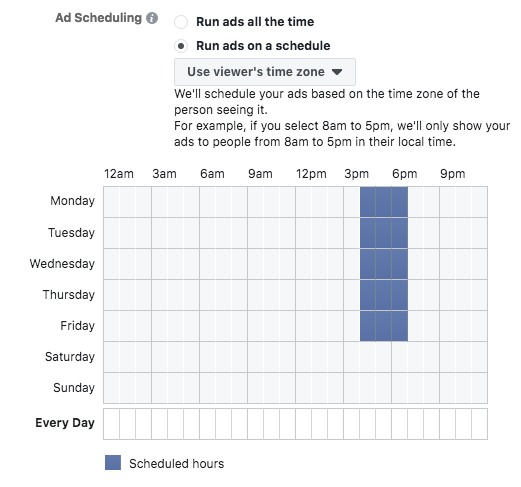
Some platforms even let your target audiences see your ad based on the users’ time zone, rather than your own, meaning you can schedule an ad to show in the evening for users across the world. If you’re starting a vegetarian meal kit, a la Blue Apron, the best day to target your audience might be Sundays, as well as Monday and Tuesday mornings, when people tend to plan and prepare their meals for the week ahead.
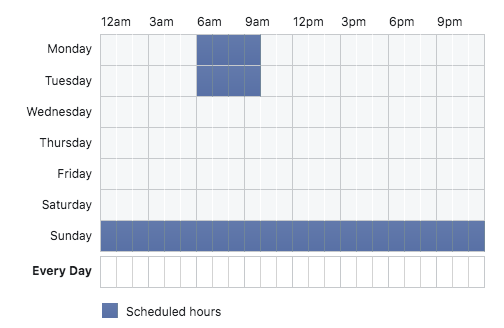
This is not an exact science, and once you launch your campaign, the results may surprise you. Maybe the midnight snack has been replaced by midnight ad engagement. Still, these time-based options allow you to narrow down your targeting. And even if you don’t want to target by hour initially, you can monitor your campaigns to see if any specific times stand out as high-performing or underperforming, then narrow down your hours based on that data.
Checking You Out
Window shopping can be fun. You get to view a product, but don’t have to talk to an eager salesman, let alone buy it. Online, however, there are tools to make sure your “window shopping” is noticed. Have you ever visited a website for a product, then seen that same company or brand pop up in your Facebook feed or show up as an ad on your favorite website? It’s no coincidence. We call it remarketing.
By setting up little snippets of code called pixels on your website, you can customize your paid social media ads to target users who visited your website and whose visit was captured by the pixel. Thanks to this, if a customer is interested enough in your product to actually visit your website, you can make sure that visit won’t be the last they’ll see of your brand. This enables your paid social media audience to create itself, to an extent. But for Facebook users, the ability to target your ideal audience does not stop there.
Facebook allows you take custom audiences and replicate them to reach people with similar characteristics to those in your custom audience. These are called Lookalike Audiences. If our budding vegetarian restaurant chain wanted to expand its targeting, it could build a Lookalike Audience on Facebook based off the profiles of people who visited its website. So if the last 5,000 website visitors tended to enjoy hiking much more than the average social media user, your Lookalike Audience would populate with users who fit the profile of a vegetarian-loving, hiking enthusiast.
The fun doesn’t stop with your website visitors. You can create Lookalike Audiences based on users who like your Facebook page, liked a certain post of yours, or other Facebook actions. Chances are that this new audience will be equally as interested, or at least close to being interested, as the audience who actually clicked into the chain’s website or took another action. Through this, you can turn a small sample of website visitors or users who took some sort of action on your content into thousands, if not millions who hopefully fit the bill and can turn into interested consumers.
Testing…1,2,3
Research can get you and your audience knowledge up to speed, but the ultimate audience data lies in how people respond to your actual campaigns. But learning more about your campaign does not mean you need to wait until it is complete. In fact, after seeing initial results, many campaigns adjust their targeting midway. A big way they are able to do this is by what we call A/B Testing.
In A/B Testing, you run multiple campaigns, with each having one variable changed across the two campaigns. Remember independent and dependent variables in science class? Same concept here. For our vegetarian restaurant, we could theoretically run an A/B Test with two ads: one with an image of a tofu salad and one with an image of a veggie burger. After we’ve spent 10 percent of our budget, for example, we could then take a look at our results and see which of the two ads is performing better. If the tofu salad image is attracting clicks at twice the rate of the veggie burger, we could then stop allocating money toward the latter ad and put more money into what is performing best.
If at First You Don’t Succeed…
Keep Trying! Just like dating, there is no perfect science to paid social media marketing. But in order to put your hard-earned paid social media budget to work, there is plenty you can do. You can “charm” your potential customers, and find better “relationship material” for consumers who are just waiting for you to market to them exactly what they want — one tofu salad at a time.

